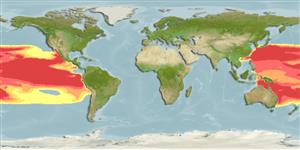>
Scombriformes (Mackerels) >
Bramidae (Pomfrets)
Etymology: Brama: Old French, breme, bresme = a fresh water fish; 1460 (Ref. 45335).
Environment: milieu / climate zone / depth range / distribution range
Ecología
marino; rango de profundidad 1 - 200 m (Ref. 58302). Temperate
Western Pacific (Ref. 559). Reported from the Hawaiian Islands (Ref. 58302).
Tamaño / Peso / Age
Maturity: Lm ? range ? - ? cm
Espinas dorsales (total) : 0; Radios blandos dorsales (total) : 33; Espinas anales: 0; Radios blandos anales: 27; Vértebra: 40. This description is base on a 4.9 cm SL specimen caught near Ogasawara Islands, Japan. Body strongly compressed. Pectoral fin situated relatively high on body. Posterior margin of preoperculum serrated.
Known only from young and juvenile specimens.
Life cycle and mating behavior
Maturities | Reproducción | Spawnings | Egg(s) | Fecundities | Larva
Masuda, H., K. Amaoka, C. Araga, T. Uyeno and T. Yoshino, 1984. The fishes of the Japanese Archipelago. Vol. 1. Tokai University Press, Tokyo, Japan. 437 p. (text). (Ref. 559)
IUCN Red List Status (Ref. 130435)
Threat to humans
Harmless
Human uses
Herramientas
Special reports
Download XML
Fuentes de Internet
Estimates based on models
Preferred temperature (Ref.
123201): 19.6 - 28.2, mean 26.1 °C (based on 126 cells).
Phylogenetic diversity index (Ref.
82804): PD
50 = 0.5039 [Uniqueness, from 0.5 = low to 2.0 = high].
Bayesian length-weight: a=0.01820 (0.00782 - 0.04232), b=2.96 (2.76 - 3.16), in cm total length, based on LWR estimates for this (Sub)family-body shape (Ref.
93245).
Nivel trófico (Ref.
69278): 4.0 ±0.6 se; based on size and trophs of closest relatives
Resiliencia (Ref.
120179): Medio, población duplicada en un tiempo mínimo de 1.4-4.4 años (Preliminary K or Fecundity.).
Fishing Vulnerability (Ref.
59153): Moderate vulnerability (36 of 100).
